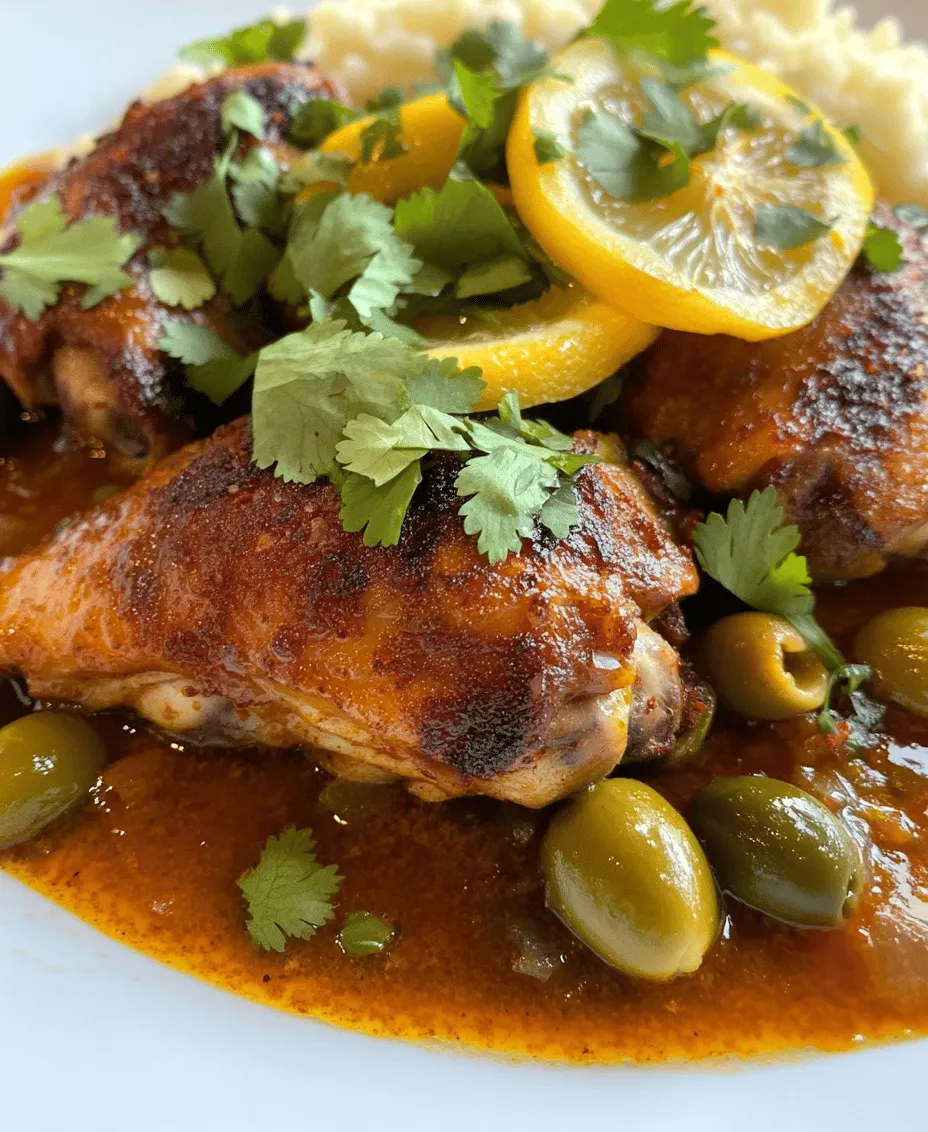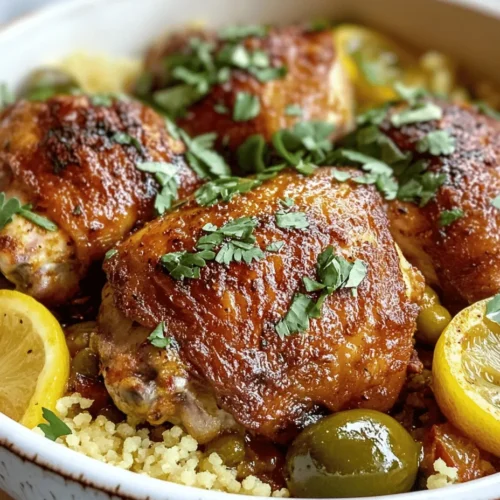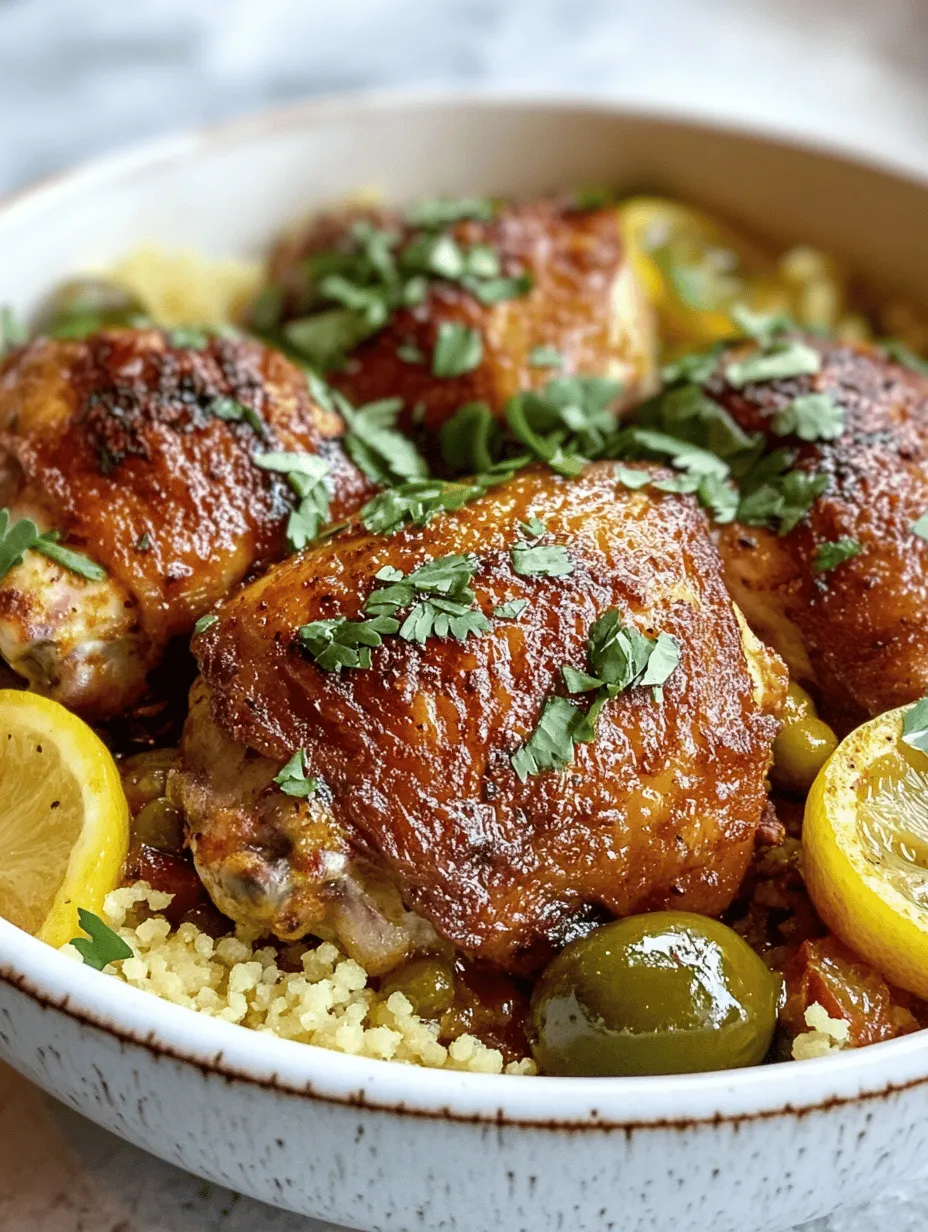Introduction to Moroccan Chicken Tagine with Olives and Preserved Lemons
Discover the rich and aromatic flavors of Moroccan cuisine with this delightful Moroccan Chicken Tagine recipe. This dish, characterized by its tender chicken thighs simmered with a medley of spices, olives, and preserved lemons, offers a unique culinary experience that transports you straight to the vibrant streets of Morocco. The combination of savory and tangy elements creates a dish that is not only satisfying but also a feast for the senses. Whether you’re looking to impress guests at a dinner party or simply craving a comforting meal, this tagine is perfect for any occasion.
In this comprehensive article, we will explore the origins of tagine, the health benefits of its ingredients, and a detailed step-by-step guide to making this flavorful dish. With its vibrant colors and enticing aromas, Moroccan Chicken Tagine is sure to become a staple in your kitchen.
The Origins and Cultural Significance of Tagine
Understanding the Tagine Cooking Vessel
At the heart of this recipe is the tagine itself, a traditional North African cooking vessel that has been used for centuries. The tagine pot is typically made of clay and consists of two parts: a shallow, wide base and a tall, conical lid. This unique design allows for even cooking and moisture retention, which is essential for the slow-simmering process that defines tagine cooking.
Historically, tagines were used by nomadic tribes in Morocco as a portable means of cooking. The dish was often cooked over an open flame, utilizing the natural heat of the fire to create rich, flavorful meals. Today, tagines are widely used in home kitchens and restaurants, symbolizing Moroccan culinary heritage.
The Role of Tagine in Moroccan Culture
Tagine is more than just a cooking method; it is a staple of Moroccan culture and a symbol of hospitality. Traditionally, tagine is served as a communal dish, placed in the center of the table for everyone to share. This practice fosters a sense of togetherness and encourages family and friends to gather and enjoy a meal together.
Moroccan meals often begin with a series of small appetizers, known as mezze, followed by the main course, which is typically a tagine. The slow-cooked nature of the dish enhances the flavors and allows for a leisurely dining experience. In Moroccan culture, sharing food is an important aspect of community, and tagine embodies this spirit perfectly.
Ingredients Breakdown and Their Culinary Importance
Essential Ingredients for Moroccan Chicken Tagine
The success of Moroccan Chicken Tagine lies in its carefully selected ingredients, each contributing to the dish’s complex flavor profile. The main protein used in this recipe is chicken thighs, which are favored for their tenderness and ability to absorb flavors during the cooking process. Chicken thighs remain juicy and flavorful even after prolonged cooking, making them the ideal choice for tagines.
Olive oil is another cornerstone of Moroccan cooking, providing depth and richness to the dish. In addition to enhancing flavor, olive oil is known for its health benefits, including heart-healthy fats and antioxidants that promote overall well-being.
Spices That Bring the Dish to Life
One of the most captivating aspects of Moroccan cuisine is its bold use of spices. The spices featured in Moroccan Chicken Tagine—ground ginger, cumin, turmeric, cinnamon, and paprika—each play a vital role in creating the dish’s signature flavor.
– Ground Ginger: Adds warmth and a hint of sweetness, balancing the savory elements of the dish.
– Cumin: Offers an earthy, nutty flavor that is essential in Moroccan cooking, enhancing the overall depth of the tagine.
– Turmeric: Known for its vibrant yellow color, turmeric contributes a mild bitterness and is celebrated for its anti-inflammatory properties.
– Cinnamon: A hallmark of Moroccan cuisine, cinnamon adds a touch of sweetness and warmth that complements the savory ingredients beautifully.
– Paprika: Provides a subtle smokiness and vibrant color, enhancing the visual appeal of the dish.
Together, these spices create a harmonious blend that characterizes Moroccan Chicken Tagine.
The Unique Additions: Olives and Preserved Lemons
Two standout ingredients that elevate Moroccan Chicken Tagine are olives and preserved lemons.
– Green Olives: These olives bring a briny, tangy flavor that complements the richness of the chicken and the spices. Their firm texture adds a delightful contrast to the tender meat, making each bite more enjoyable.
– Preserved Lemons: A quintessential ingredient in Moroccan cuisine, preserved lemons are made by curing lemons in salt and their own juices. This process softens the lemons and intensifies their flavor, resulting in a tangy, salty addition that brightens the dish. The unique tartness of preserved lemons cuts through the richness of the tagine, creating a well-balanced meal.
Together, olives and preserved lemons add layers of flavor that are integral to the authenticity of Moroccan Chicken Tagine.
Preparing Moroccan Chicken Tagine: Step-by-Step Instructions
Prepping the Chicken for Optimal Flavor
Before diving into the cooking process, it’s crucial to prep the chicken properly to ensure maximum flavor. Start by selecting high-quality chicken thighs, preferably bone-in and skin-on, as this will provide the best taste and texture. To enhance the flavor, it is important to dry the chicken thighs thoroughly with paper towels. This step helps achieve a nice sear during cooking, which is essential for developing a rich flavor base.
Once the chicken is dried, season it generously with salt and pepper. This simple step enhances the natural flavors of the chicken and prepares it for the bold spices that will follow. For an added depth of flavor, consider marinating the chicken in a mixture of olive oil, garlic, and some of the spices for at least an hour, or even overnight if time allows. This not only infuses the chicken with flavor but also helps to tenderize the meat, resulting in a succulent tagine.
Creating a Flavor Base with Onions and Spices
The next step in preparing Moroccan Chicken Tagine involves creating a robust flavor base. Begin by heating a generous amount of olive oil in the tagine pot or a heavy-bottomed Dutch oven over medium heat. Once the oil is hot, add finely chopped onions and sauté them until they become translucent and fragrant. This process typically takes about 5-7 minutes and is essential for building the dish’s foundation of flavor.
As the onions soften, add minced garlic and sauté for an additional minute, being careful not to let it burn. The combination of onions and garlic releases aromatic compounds that will infuse the entire dish with savory goodness.
Once the onions and garlic are ready, it’s time to add the spices. Sprinkle in the ground ginger, cumin, turmeric, cinnamon, and paprika, stirring to coat the onions evenly. Allow the spices to toast for a minute or two, releasing their essential oils and enhancing their flavors. This step is important, as it transforms the spices and allows them to permeate the dish.
With the flavor base established, you are now ready to add the chicken and continue building this aromatic Moroccan Chicken Tagine.
In the upcoming sections of this article, we will delve deeper into the cooking process, including how to incorporate olives and preserved lemons, as well as tips for serving and enjoying this delightful dish. Stay tuned for more insights into creating the perfect Moroccan Chicken Tagine that will impress family and friends alike!

How to Properly Introduce Spices to Enhance Aroma
Spices are the heart and soul of Moroccan cuisine, and their introduction during the cooking process is crucial for developing depth and flavor. When preparing your Moroccan Chicken Tagine, it’s important to layer your spices correctly. Start by heating your oil in the tagine or a heavy casserole on medium heat. Once the oil is shimmering, add your aromatics, like onions and garlic, and cook until they are softened. This step not only builds a flavor base but also releases the essential oils in the spices, enhancing their aroma.
Once your onions are translucent, add your spices—cumin, coriander, turmeric, ginger, and cinnamon. The key is to let the spices “bloom” for about 30 seconds to a minute. This means stirring them into the oil and allowing them to cook briefly. This process activates the spices, allowing them to release their aromatic compounds, and will infuse your chicken with an incredible scent and flavor.
Simmering for Succulent Chicken
To ensure your chicken remains tender and juicy throughout the cooking process, it’s vital to control the simmering temperature. After browning your chicken and adding the spices, pour in your broth and bring the mixture to a low simmer. The key is to maintain a gentle simmer rather than a vigorous boil, which can dry out the meat.
Techniques for Maintaining Moisture During Cooking
To keep the chicken moist, cover the tagine or pot with a lid while it simmers. This will trap steam and help retain moisture. If you’re using a tagine, the conical lid is designed to circulate moisture back into the dish. Additionally, you can add a little extra broth or water if the sauce begins to reduce too much. Regularly check on your dish, ensuring that it doesn’t dry out.
Tips for Checking Chicken Doneness
The chicken should be cooked through but not overcooked. To check for doneness, use a meat thermometer; the internal temperature should read 165°F (75°C). Alternatively, you can check by piercing the chicken with a fork; the juices should run clear, with no pink remaining. If the chicken is not yet done, continue simmering and checking every few minutes.
Incorporating Olives and Preserved Lemons
Once your chicken is nearly finished cooking and is tender, it’s time to add the olives and preserved lemons. This step is crucial for maintaining their distinct flavors and textures.
Timing for Adding Olives and Lemons to Maintain Flavor
Add the olives and preserved lemons during the last 15-20 minutes of cooking. This timing allows them to heat through and impart their flavors into the tagine without becoming overly mushy. The preserved lemons add a unique tanginess, while the olives contribute a briny depth that balances beautifully with the spices.
Mixing Techniques to Preserve the Texture of Ingredients
When incorporating olives and preserved lemons, use a gentle folding technique rather than stirring vigorously. This will help maintain the integrity of the ingredients, ensuring the olives remain whole and the lemons retain their shape. Simply lift and turn the chicken and sauce over the olives and lemons, allowing them to mix while preserving their textures.
Cooking Couscous: A Perfect Accompaniment
Couscous is a traditional Moroccan staple that pairs perfectly with chicken tagine. Its fluffy texture and ability to absorb flavors make it an ideal side dish.
Quick Guide to Preparing Fluffy Couscous
To prepare couscous, use a ratio of 1 cup of couscous to 1.5 cups of liquid (water or broth). Bring the liquid to a boil, then remove it from heat and stir in the couscous. Cover it with a lid and let it sit for about 5 minutes. Afterward, fluff it with a fork to separate the grains. For added flavor, consider mixing in a drizzle of olive oil or a sprinkle of spices that echo those used in your tagine.
How Couscous Complements the Tagine
Couscous serves as a perfect base for your Moroccan Chicken Tagine, soaking up the rich sauce and spices. Its subtle flavor allows the boldness of the tagine to shine, creating a harmonious balance on the plate. The texture of the couscous contrasts nicely with the tender chicken and the briny olives, enhancing the overall dining experience.
Serving Suggestions and Presentation Tips
Arranging the Dish for Maximum Appeal
When it comes to serving your Moroccan Chicken Tagine, presentation is key. Start by placing a generous helping of couscous on the plate or a shallow bowl. Nestle the chicken pieces atop the couscous, spooning over some of the aromatic sauce. To enhance the visual appeal, arrange the olives and preserved lemon slices around the chicken.
Garnishing Techniques with Fresh Herbs
A sprinkle of freshly chopped cilantro or parsley can elevate your dish, adding a pop of color and freshness. You might also consider adding a few slivers of toasted almonds or pine nuts for an added crunch and flavor contrast.
Pairing Suggestions for a Complete Meal
For a complete Moroccan dining experience, consider serving your chicken tagine with a side of Moroccan carrot salad or a refreshing cucumber and tomato salad. These salads offer a crisp and fresh counterpoint to the rich and aromatic flavors of the tagine.
Recommended Side Dishes and Beverages
Beverage pairings can enhance the meal’s flavors. Consider serving Moroccan mint tea, which complements the spices beautifully, or a light, fruity white wine. For a non-alcoholic option, a pomegranate juice spritzer can provide a refreshing contrast to the savory dish.
Cultural Context of Meal Pairings in Moroccan Dining
In Moroccan culture, meals are often communal, with family and friends gathering to enjoy dishes together. This sense of sharing and hospitality is integral to the dining experience. Serve your Moroccan Chicken Tagine with ample portions of side dishes and drinks, encouraging your guests to fill their plates and enjoy the flavors of Morocco together.
Health Benefits of Moroccan Chicken Tagine
Nutritional Insights of Key Ingredients
Moroccan Chicken Tagine is not only delicious but also packed with nutritional benefits. Chicken thighs are a great source of protein, providing essential amino acids for muscle repair and overall health. They are also rich in B vitamins, which help with energy production, and contain iron, crucial for oxygen transport in the body.
Health Benefits of Olives and Preserved Lemons
Olives are loaded with healthy fats, particularly monounsaturated fats, which can help lower bad cholesterol levels. They also contain antioxidants and anti-inflammatory compounds, contributing to overall heart health. Preserved lemons, rich in vitamin C and fiber, aid in digestion and boost the immune system, making them a fantastic addition to your diet.
The Role of Spices in Wellness
The spices used in Moroccan Chicken Tagine are not just for flavor; they also offer health benefits. For instance, turmeric contains curcumin, which is known for its anti-inflammatory properties. Ginger has been recognized for its digestive benefits, while cinnamon may help regulate blood sugar levels. Incorporating these spices into your meals can enhance your overall well-being and add a flavorful dimension to your cooking.
Conclusion: Embracing the Essence of Moroccan Cuisine
Moroccan Chicken Tagine with Olives and Preserved Lemons is more than just a meal; it is a celebration of flavors, culture, and tradition. By preparing this dish, you not only create a delicious dining experience but also embrace the rich heritage of Moroccan cooking. As you savor each bite, you’ll appreciate the harmonious blend of spices, the tenderness of the chicken, and the unique tang of preserved lemons. This recipe invites you to explore the world of Moroccan cuisine and brings a touch of its vibrant essence into your home. Enjoy the journey as you prepare and share this exquisite dish with loved ones.



